Stephen Crawford never planned to be an artist. In fact, if you had asked him fifteen years ago, he might have laughed at the idea. Art was something other people did—people with training, talent, or a lifelong calling. Crawford didn’t think he fit into any of those categories. Then a friend dragged him to an art class. That one class cracked something open. He hasn’t looked back since.

It wasn’t a neat or easy shift. Crawford talks about his path to painting as long and unlikely. He didn’t grow up seeing himself as artistic. He didn’t dream of gallery shows or sketchbook afternoons. But once that door opened, he stepped through it like it had been waiting for him all along. He says now that becoming an artist wasn’t something he chose—it chose him. And it hasn’t let him go.
Crawford doesn’t treat art like a hobby or a career. It’s something deeper, harder to explain. He calls it a passion. Sometimes an obsession. It’s a need to make something visible that lives inside. He paints because he has to.
His work, like his story, doesn’t come from convention. It comes from feeling. From watching. From being moved by what he sees and trying to translate that into color, shape, and mood. One of his paintings, Stormy Water’s Ahead, shows this clearly. The scene is a beach in Iceland. The sea churns, clouds roll in, and the light filters through in soft beams. It’s dramatic. But it’s not just a landscape—it’s a message. Crawford talks about how, even in the dark, there are rays of hope. That’s what pulled him to the scene. The way chaos and calm can share the same frame.
That sense of contrast runs through much of his work. Light and dark. Stillness and movement. Fear and faith. He doesn’t force these opposites to resolve. He lets them sit together. That honesty is part of what makes his paintings resonate. They’re not just pretty or skillful. They carry something lived.
Even though Crawford came to painting later in life, his approach doesn’t feel uncertain. There’s a quiet confidence in the way he talks about his work. Not ego—but clarity. He knows what painting gives him, and he knows what he wants to give back. He paints not to prove anything, but to share what he sees. Sometimes what he sees is beauty. Sometimes it’s stormy. Often, it’s both.
There’s also a kind of humility to the way he describes his journey. He doesn’t call himself a visionary. He doesn’t build himself up. Instead, he points to the strange, surprising way art found him. And how he hasn’t been able to let it go since. That deep pull toward making, toward creating something from the inside out, keeps him moving forward.
Crawford’s subject matter often leans toward the elemental—landscapes, skies, water, weather. He captures moments that feel both massive and intimate. A cloud formation that looks like it might swallow the sea. A patch of light breaking through storm. These are not just scenes—they’re emotions, stories, reflections. He paints them not to document, but to express. To hold a feeling in place.
He doesn’t aim for photorealism. He’s after something more atmospheric. The mood of a place. The way it lives in memory. The way it stirs something inside. His colors are thoughtful, often deep and brooding. But always there’s a touch of light—a reminder, perhaps, of that lesson he took from Iceland: there is always light in the darkness.
Fifteen years in, Crawford is still discovering. Still learning. Still painting because he has to. He doesn’t talk about awards or shows. He talks about process. About being honest with the work. About how surprising it still is that this is what he does now—what he is now.
What started as an unexpected favor to a friend has turned into a full way of seeing and being. Crawford might not have seen it coming, but once it arrived, it was undeniable. He became an artist the moment he picked up the brush and realized something within him had been waiting for that moment all along.
That’s what makes his work feel personal—because it is. Every piece carries that initial shock of discovery, that first flicker of recognition. And in each painting, you can sense that same invitation: to look deeper, to feel more, and to find your own sliver of light in the storm.

